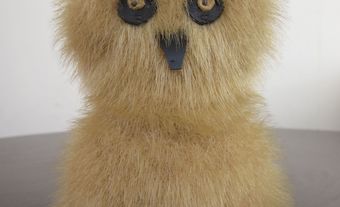Quilt
Quilt as a noun refers to layers of material fastened together. Historically and traditionally, the materials in the top and bottom layer are fabrics such as cotton and/or wool, the filling in between the layers a soft batting of cotton or wool fibres. All three layers are held together in a pre-decided pattern of decorative rows of fine and even-running stitches traditionally sewn by hand, or sometimes by hand tying at regular intervals. This stitching is called quilting. Modern quilters may use a sewing maching for quilting.
Quilts were first made in Canada in the late 18th century with the arrival of settlers from the British Isles and the US. However, since the late 20th century, the activity of quiltmaking has expanded considerably - and so too has the meaning encompassed by the word "quilt." Today, quilts may be functional and/or decorative, and categories include antique quilts (made before the 1900s, with many found in private and museum collections), traditional quilts (for a bed, design copied from patterns and techniques of the early 20th century), contemporary quilts (using traditional patterns or variation thereof with today's fabrics, sized primarily for a bed), wall quilts (many sizes and variations of traditional and/or original designs), miniature quilts (very small size) and quilted articles (wearables, household). The Art Quilt, designed to be viewed on a wall, employs original designs based on conventional quiltmaking practice but may have as few as 2 layers of primarily textiles held together, which could include paper, metal, beading, etc. Within these categories there are variations as well. Quilts currently encompass whatever the maker envisions for its purpose.
In the past, traditional patterns or surface designs were developed and passed on to makers so that many quilts of the same design, with names such as Log Cabin, Lone Star and Dresden Plate, could be made and shared. Colour arrangements and quilting designs varied depending on the available materials. Those quilts that have survived from the 19th century, and even earlier, can be found in museum, government and gallery collections and are eagerly sought by private collectors. They continue to offer inspiration for quiltmakers today, who use an ever increasing range of fabrics manufactured especially for quiltmaking. In fact, quilt shops providing fabrics, books, magazines, notions and classes for quiltmakers can now be found nationally and are a growing business. The internet has numerous quilt-related websites devoted to selling these same supplies. Websites also provide free patterns and ideas, and act as visual resource libraries for beginning quiltmakers as well as studio fabric artists. Many quiltmakers and fabric artists have their own websites from which to sell their work. Statistically and economically, the making and selling of contemporary quilts has become an industry.
Techniques for making the surface design of a quilt vary greatly. These include sewing by hand or with a sewing machine using traditional and new patterns with their variations, and can include the use of computer technology, painting, dyeing, printing, paper, photography on fabric, etc. Thread used may be shiny or dull, using rayon, metallic, cotton, cotton/polyester or nylon. The computerized sewing machine, guided by the hand of the quiltmaker, may do random free-motion machine quilting or use a machine stitch that mimics the traditional running stitch. Piecework, patchwork, appliqué, collage, embellishment and fusing are some of the techniques employed in the construction of quilts. The maker has the choice of any method that enhances the surface design.
Some makers of quilts have become teachers who give workshops and lectures at local guilds and at national and international conferences devoted to quiltmaking. Juried and invitational exhibitions of quilts in galleries and museums educate the public about the art form and beauty of quilts and the skill of the makers. Catalogues of these exhibitions are often available and prizes and awards are given in juried exhibitions.
Quiltmakers maintain professional contact through various community, national and international fibre organizations and as members of quilting guilds. In Canada, the Canadian Quilters' Association/Association canadienne de la courtepointe represents Canadian quiltmakers nationally with a biennial conference, an annual juried exhibition and a quarterly magazine for members.
In the past, most of the quiltmaking was done by women. Today quiltmakers also include men. Some quiltmakers make quilts and quilt-related articles as a hobby or as a part-time activity; others are full-time independent studio artists professionally exhibiting, teaching and designing one-of-a-kind art quilts on commission, for exhibition and for sale in fine art galleries.
Today the material chosen for the surface layer and the design and size still determine whether the quilt is intended by the maker to be functional or decorative. The quiltmaker is allowed great artistic freedom to challenge the concept of a quilt beyond the traditional and historical parameters. Whether it is made as a gift for a family member or for a commemorative occasion, expresses a special theme or message, or is a quilt exhibition entry, a commission for a specific site or designed as a one-of-a-kind, each quilt bears the mark of the individual maker.

 Share on Facebook
Share on Facebook Share on X
Share on X Share by Email
Share by Email Share on Google Classroom
Share on Google Classroom


